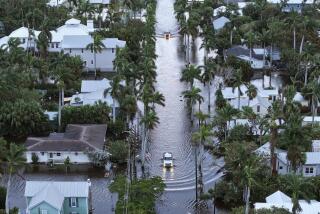UPDATE : Despite Calm, Hurricane Survivors Keep Their Guard Up : Luis is not an immediate threat, but many Floridians remain shuttered. They recall Andrew’s ire three years ago.
HOMESTEAD, Fla. — Despite the bright midmorning sun, it is dark inside Domingos Gonsalves’ house. “I’m going to keep the storm shutters up for a few more weeks,” he explains. “I feel safer.”
No particular storm threatened South Florida last week, but at the peak of a hurricane season that is already the most active in 62 years, Gonsalves and most of his neighbors in this area called the Redlands don’t need to know which bully might blow in next. Three years have passed since Hurricane Andrew brutalized this section of South Dade County, and it is enough to know that Luis, a storm of similar might, is out there and moving this way.
“On the day that Hurricane Erin was coming, we left for Portugal. It was the first time I’ve been back to my birthplace in 22 years,” says Gonsalves, 57. “I was worried about going, but my sons say, ‘Go.’ They put the shutters up. But all the time we were there, I was watching CNN International and calling home. You don’t forget.”
With winds of 145 m.p.h. or higher, Andrew was blamed for at least 17 deaths and property losses of $30 billion, making it the costliest single natural disaster in U.S. history. For those who survived, the storm’s legacy of terror is impossible to measure.
Sweat and insurance money have lent a rebuilt, refurbished sheen to most of the homes and nearby stores. But the memories of that Aug. 24, 1992, are as fresh as the paint.
Gonsalves’ next-door neighbors on 274th Street, the Cumbies, all six of them, jammed into a bathroom and for almost two hours pooled their collective might to keep the door from flying off as the ceiling lifted. Two houses away, a terrified Marcia and Ken Pitt huddled in a closet and listened helplessly while the wind sucked out the insides of their dream house. Around the corner Ron Bishop narrowly escaped with his life as his two-story house, built on stilts in a pine grove, wobbled and then collapsed in an explosion of splinters.
Inexplicably, Gonsalves slept through the howling of the storm, even as the windows blew out. But the aftermath, when his homeless parents and two of his sons moved in and his concrete paving business foundered, almost did him in. The heat, the stress and four weeks without electricity frayed everyone’s nerves.
His wife, Otilia, “is nervous all the time,” he says. “She is better, but this has taken a while.”
Materially, many people benefited in the storm’s wake. Living on insurance money and his wife Amy’s earnings as a seamstress, Doug Cumbie has spent the last three years at home: re-roofing, tiling an enlarged patio and pool deck, even laying a hardwood floor in a hallway. Now, with his eldest child looking at college next year, “I’m trying to decide what to do with the rest of my life,” says Cumbie, 49, a former technical writer.
The Pitts’ home is once again the block’s most impeccable, their yard a verdant, manicured garden. “We have four- and five-foot trees where we used to have 20-foot trees, and we spent $20,000 to $30,000 we got in an inheritance to extend the patio and put a fireplace in,” says Ken Pitt, 50, an accounting teacher and athletic business manager at a nearby high school. “We’re very happy with the way it turned out.”
And Gonsalves says he has done very well pouring concrete to resurface roads and build shopping center parking lots. His three sons have prospered, too. George, 28, who works in the family business, just built a house on a lot behind his parents’ property.
Of these neighbors, only Bishop has failed to profit financially from the storm. He had no insurance on his $180,000 house, and he lost everything, including his lot. On that land now, surrounded by 10-foot weeds and dead pine trees, sits a rundown trailer, the home of an indigent woman named Helen who says she is being evicted by the county.
Bishop, 43, who worked as a roofer, and his daughter, a 17-year-old high school senior, left the area after the storm, fleeing, he says, “sleaze bags who came in to rip people off.”
He now lives in Floral City, a small town north of Tampa, on Social Security disability. “Life is better,” he reports. “I’m easier to get along with, and pretty content being retired. And I’m never coming back to Miami.”
The hurricane’s emotional legacy is harder to measure. But a host of researchers have been studying survivors, trying to get a fix on what University of Miami psychiatry professor Raquel Cohen calls their “psychological and biological memory.”
“Hurricane Andrew left people more vulnerable,” she says. “And there is so much more awareness now, with the news media reporting every little storm which starts in Africa and may never come close to the United States. That heightens the tension.”
Indeed, even though Erin was a minimal hurricane and veered away from South Florida to cross the state’s midsection, this active season is taking a toll in anxiety. The Gonsalveses are not the only ones in the neighborhood who have left the storm shutters up.
“Before Andrew, we just didn’t know what would happen,” says Amy Cumbie. “But Andrew shocked me. Before Erin, we spent two days getting ready, putting things away.”
Marcia Pitt, a media specialist at an elementary school, counts increased patience and an appreciation for her neighbors as the positive lessons Andrew left her. She also knows she can survive four weeks without electricity in the steamiest days of subtropical summer.
But she also carries with her the memory “of being in that dark closet, listening to the sounds of the house being destroyed.”
“Now, if there is fog, rain or wind from the east blowing against the windows, I wake up. Before I would have slept through it, but now I automatically sit up and can’t go to sleep until I get that anxiety level down. That’s the bad.”
Surprisingly, Doug Cumbie says, his four children, who range in age from 12 to 17, now recall their experience with Andrew as “a happy adventure. They remember the camping, the cooking outside. They think it would be cool if we had a lot of hurricanes.
“But I get the heebie-jeebies, I do.”
(BEGIN TEXT OF INFOBOX / INFOGRAPHIC)
Coming Back from the Storm
Hurricane Andrew tore apart houses and lives in the neighborhood known as the Redlands. While many have rebuilt here, memories of the storm’s terror linger.
Where They Stand:
Bishop: Uninsured home collapsed in the storm. Is now living on Social Security disability in Floral City, Fla.
Cumble: Living on wife’s earnings and insurance money, family has spent three years repairing and improving house.
Gonsalves: Owner has repaired home, concrete paving business has prospered.
Pitt: Rebuilt home is once again the block’s most impeccable.
More to Read
Sign up for Essential California
The most important California stories and recommendations in your inbox every morning.
You may occasionally receive promotional content from the Los Angeles Times.










